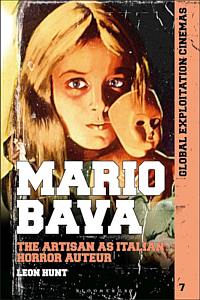One of the big names of Italian movie art, or in this case the horror and crime movie genre, Mario Bava (1914-1980) is the subject of this study on European “auteur-cinema” of the 1960s and 1970s.
 Without Bava, there would be no such genre masterpieces as Danger: Diabolik (1968), Kill Baby … Kill (1966), Baron Blood (1972), Black Sabbath (1963), Revenge of the Vampire (1960), The House of Exorcism (1975), or Planet of the Vampires (1965), a sci-fi movie that shares many similarities with the set and story of Ridley Scott’s Alien.
Without Bava, there would be no such genre masterpieces as Danger: Diabolik (1968), Kill Baby … Kill (1966), Baron Blood (1972), Black Sabbath (1963), Revenge of the Vampire (1960), The House of Exorcism (1975), or Planet of the Vampires (1965), a sci-fi movie that shares many similarities with the set and story of Ridley Scott’s Alien.
Bava stated out with a couple of sword and sandal movies in the late 1950s, when such films became popular in Europe. Later, he directed, wrote and co-wrote several Westerns, action movies and horror films. Often, they would incorporate style, methods, and features of the other genres, too. From a very early stage on, stylish photography would inform his movies. Many of his productions became so-called “cult movies.”
Bava received international recognition with his vampire and horror films, especially the gialli. Actually, he was one of the directors who invented the genre. His 1963 The Girl Who Knew Too Much/La ragazza che sapeva troppo (aka Evil Eye for the US and UK market) is widely considered the first giallo movie ever made. Although it took several decades before he became a household name in cineast circles outside of Europe. Before that, he was just another somewhat obscure director from Italy, whose movies would simply be unavailable outside his own country. A fate he shared with other Italian directors equally affiliated with the giallo genre, like Dario Argento, Michele Soavi, Pupi Avati, Lucio Fulci and others.
Leon Hunt’s title, apart from recreating Bava’s various career stages, approaches these main questions: how can a director develop an individual style, if his films came out in different cuts and editions, and not just once? (For example, his early success, the low-budget film Revenge of the Vampire also came out as Black Sunday, The Mask of Satan and of course under the Italian title La maschera del demonio). And why were his cooperation and his inspiration for several other French and Italian movies of the time so often obscured and sometimes hushed up? The book also explores Bava’s “… formal and narrative properties of a filmography marked by an emphasis on spectacle and atmosphere over narrative coherence and the ways in which his lauded cinematic style intersects with different production contexts.” Because often enough, Bava was called in to save a half-finished production and replace another director, and in return, he rarely was credited as such, or was needed as a fixer to rescue some special effects or assisted later in the editing stage.
Basically, Hunt elaborates on those production contexts. As for Bava, such conditions – unsteady, uncertain and mostly also not very well-paid jobs – were the standard work environment. Six chapters deal with details of his many productions in chronological order and his respective roles and time of engagement with the films. The best parts may be chapters 4, Bava and the Italian-style thriller, and 5: Bava and film style.
The director died in 1980, he never could enjoy his success, as only years later his exploits were appreciated for what they were: masterpieces of horror film, the majority of those finished under extremely difficult circumstances. And the movies were shot usually on small budgets, and Bava had to make the best out of generally poor scripts and work on thigh schedules. After all, he was a “filmmaker’s filmmaker” and an “artisan-auteur.” The “… filmmaker-as-artisan always brings us back to the matter of creative labor, to what filmmakers can do, and have done, in particular circumstances. The artisan reminds us of filmmaking as work, as a set of technical and aesthetic challenges and a body of films as a sometimes-unpredictable career. The figure of the auteur retains its romantic allure, but artisans deserve our attention, too.”
Bava was a unique director, an artist who utilized depictions of pure ferocity (and even sadistic scenes or torment), as well as a strong eroticism paired with special effects and a design “… that made films look more expensive than they were, [he was] a cinematic stylist skilled in fashioning macabre atmospheres and lurid violent set pieces.”
So many fans would probably state that they immediately remembered the way the movie was designed, cut, and recall the atmosphere and mood of several scenes; the plot, however, would be remembered least. Bava’s films are mostly loved (and often categorized) for their complex and unusual style and air, rather than powerful plots.
Mario Bava: The Artisan as Italian Horror Auteur nails and reviews some of the director’s unusual methods and aesthetics by pointing to some key titles, film sets and certain characters/types in his movies. The book is by far not a complete biography or exhaustive portrait of the director. Nevertheless, that does not matter, as there are other volumes (even a few in English) that take care of that. Here, cinephiles and fans of his unique visual style will find man details and clues to access some of his most bizarre scenes, films and movie sets. It comes with an index and a selected filmography. (This is a review of the first paperback edition; the title was originally published in 2022).
Review by Dr. A. Ebert © 2024
Leon Hunt. Mario Bava: The Artisan as Italian Horror Auteur. Bloomsbury Academic (Global Exploitation Cinemas Series), 2023, 240 p.
